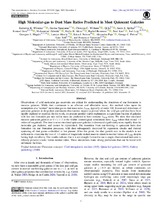| dc.identifier.citation | Whitaker, Katherine & Narayanan, Desika & Williams, Christina & Li, Qi & Spilker, Justin & Davé, Romeel & Akhshik, Mohammad & Akins, Hollis & Bezanson, Rachel & Katz, Neal & Leja, Joel & Magdis, Georgios & Mowla, Lamiya & Nelson, Erica & Pope, Alexandra & Privon, George & Toft, Sune & Valentino, Francesco. (2021). High Molecular-gas to Dust Mass Ratios Predicted in Most Quiescent Galaxies. The Astrophysical Journal Letters. 922. L30. 10.3847/2041-8213/ac399f. | en_US |
| dc.description.abstract | Observations of cold molecular gas reservoirs are critical for understanding the shutdown of star formation in massive galaxies. While dust continuum is an efficient and affordable tracer, this method relies upon the assumption of a "normal" molecular-gas to dust mass ratio, δGDR, typically of order 100. Recent null detections of quiescent galaxies in deep dust continuum observations support a picture where the cold gas and dust have been rapidly depleted or expelled. In this work, we present another viable explanation: a significant fraction of galaxies with low star formation per unit stellar mass are predicted to have extreme δGDR ratios. We show that simulated massive quiescent galaxies at 0 < z < 3 in the simba cosmological simulations have δGDR values that extend >4 orders of magnitude. The dust in most simulated quiescent galaxies is destroyed significantly more rapidly than the molecular gas depletes, and cannot be replenished. The transition from star-forming to quiescent halts dust formation via star formation processes, with dust subsequently destroyed by supernova shocks and thermal sputtering of dust grains embedded in hot plasma. After this point, the dust growth rate in the models is not sufficient to overcome the loss of >3 orders of magnitude in dust mass to return to normal values of δGDR despite having high metallicity. Our results indicate that it is not straight forward to use a single observational indicator to robustly preselect exotic versus normal ratios. These simulations make strong predictions that can be tested with millimeter facilities. | en_US |

